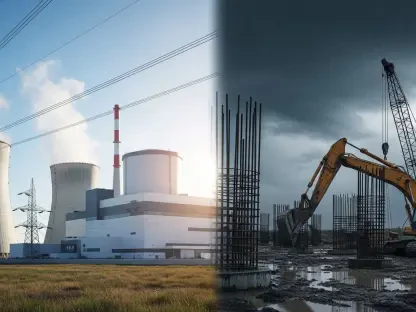Hydropower often stands as a beacon of sustainable energy, promising to reduce carbon emissions and encourage energy security. However, when these projects target transboundary rivers shared by multiple countries, their implementation uncovers numerous hidden costs and complexities. These challenges can lead to geopolitical tensions, environmental degradation, and socio-economic disruptions, undermining the notion of hydropower as a purely advantageous energy solution. The delicate balance between exploiting renewable resources and preserving international and ecological harmony becomes even more crucial in these contexts.
The Dark Side of Hydropower on Transboundary Rivers
One prominent example of this intricate balance is China’s proposed mega dam on the Yarlung Tsangpo river in Tibet, also known as the Brahmaputra river. While China regards the initiative as a leap toward energy efficiency and renewable energy milestones, neighboring countries such as India and Bangladesh, along with local Tibetan populations, harbor grave concerns about its possible consequences. Expected to possess three times the power capacity of the already colossal Three Gorges Dam, the Yarlung Tsangpo dam project exemplifies the conflicts inherent in the pursuit of cleaner energy.
The envisioned benefits of hydropower, such as substantial reductions in carbon emissions and enhanced energy security, can sharply contrast with the problematic realities of its execution. Large-scale dam projects frequently disrupt ecosystems, trigger deforestation, and necessitate the displacement of local populations, thus injecting a human rights perspective into the debate. These adverse effects can tarnish the noble objective of achieving renewable energy, necessitating a closer examination of the development practices surrounding hydropower.
Uneven Distribution of Benefits and Costs
The discord between the advantages and disadvantages of hydropower projects often falls along the lines of societal structures, with urban elites typically reaping the rewards of clean electricity, while marginalized communities bear the majority of the negative impacts. According to Susanne Schmeier from the IHE Delft Institute for Water Education, beyond the primary goal of generating clean electricity, a significant focus must be laid on ensuring that the benefits extend to all, including the adversely affected communities. However, the reality remains that preventive measures intended to alleviate adverse effects are seldom foolproof, and severe problems might still arise.
Transboundary hydropower projects introduce an added layer of complication as domestic laws are often ill-prepared to address the broader repercussions that extend beyond national borders. Environmental and social assessments tend to focus solely on the host country, leaving neighboring populations and nations uninformed, fostering mistrust, misinformation, and misunderstanding. These gaps in regulatory frameworks underscore the need for more inclusive and cross-boundary assessments to mitigate the inherent uncertainties of such projects.
Local Communities and Geopolitical Tensions
The issue becomes even more pronounced in regions like Tibet, where local communities grapple with barriers resulting from their colonial status under Chinese control. Tibetans possess minimal say in decision-making regarding their land and often encounter suppression when attempting to voice grievances. This lack of agency compounds the challenges associated with hydropower development, raising critical concerns about the intersection of environmental policy and human rights.
Downstream nations such as India and Bangladesh are apprehensive of the geological, ecological, and social tolls anticipated from the dam, highlighting the potential for these projects to ignite or intensify geopolitical tensions. Schmeier remarks that water conflicts in this region interweave with broader border disputes, with upstream nations inclined to prioritize their interests at the expense of their neighbors. The opacity surrounding China’s progress and intentions further exacerbates these tensions, underscoring the importance of transparency and cooperative mechanisms in averting conflict.
International Governance Mechanisms
Several international frameworks, like the UN Watercourses Convention and organizations such as the International Hydropower Association (IHA), propose governance mechanisms for managing shared water resources. Nevertheless, their efficacy is frequently undermined by non-universal adoption and the voluntary nature of compliance. Power imbalances further skew decision-making processes, with upstream nations wielding greater political leverage often sidelining the interests of downstream countries. Furthermore, local communities are frequently excluded from these processes due to barriers including language and financial costs, compounding the challenge of equitable governance.
These international frameworks also often fail to incorporate the complex political, geographic, and ecological nuances unique to different river basins. Ana Maria Daza Vargas of the University of Edinburgh points out that implementing international law is relatively straightforward in smaller river basins involving fewer countries, whereas larger basins pose significantly more formidable challenges. Another noteworthy issue is that foreign investors and developers typically adhere strictly to international investment laws and domestic regulations, frequently bypassing international human rights and environmental laws, further complicating accountability.
Accountability and Cooperation
Navigating the murky waters of accountability in transboundary hydropower projects proves to be an arduous task with numerous parties involved. Foreign investors often rely heavily on information from host states, thereby exposing themselves to risks if that information proves incomplete or erroneous. Schmeier emphasizes that conflicts are more probable in scenarios where governance mechanisms are either weak or absent, advocating for the necessity of fostering cooperation from the outset of project development.
Taking the Grand Ethiopian Renaissance Dam (GERD) as an illustrative example, Schmeier underlines the imperative for upstream countries to engage in open dialogue and cooperative measures, such as prior notifications and transboundary impact assessments. Such collaborative endeavors can mitigate the element of surprise and counteract mistrust, thereby thwarting potential conflicts. Schmeier stresses that nations should prioritize long-term thinking and consider looking beyond traditional notions of sovereignty, recognizing the mutual benefits inherent in cooperation over unilateral actions.
Effective Governance and Community Empowerment
Hydropower is often viewed as a pillar of sustainable energy, promising significant reductions in carbon emissions and bolstering energy security. It plays a critical role in the global shift towards renewable resources. However, the reality becomes more convoluted when these projects are proposed on transboundary rivers shared by multiple nations. The implementation of such hydropower projects frequently reveals a range of hidden costs and complexities. One major issue is the potential for geopolitical tensions, as countries may clash over water rights and usage.
Additionally, the environmental impacts can be severe, including habitat disruption for aquatic and terrestrial species. This can lead to a loss of biodiversity and ecological imbalance. On a socio-economic level, these projects can displace communities, affect livelihoods, and generate economic disparities. Such consequences challenge the perception of hydropower as an entirely beneficial energy solution.
The intricate balance between harnessing renewable energy and maintaining international cooperation and ecological preservation becomes crucial in these situations. As we move forward, careful consideration of these factors is essential to navigate the multifaceted implications of hydropower on shared international rivers. This ensures that while we progress towards sustainable energy goals, we also maintain harmony among nations and protect the environment for future generations.









